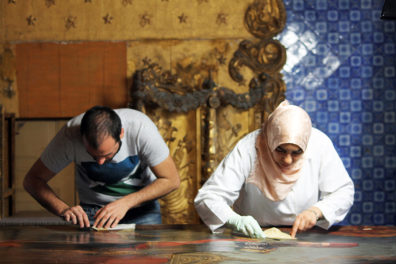
Getty bibliographer Simone Fujita holds books from the collection
Since Getty announced the African American Art History Initiative, the team has been at work building out the library and research collections. Simone Fujita is the official bibliographer in charge of developing the library’s holdings around African American art. This means she’s thinking about books all the time.
“When people hear that we are building a library collection on African American art, they most probably imagine that we are purchasing exhibition catalogues featuring modern and contemporary painters,” says Fujita.
The reality is that the scope is much broader, including “every imaginable genre and form of African American artistic expression—from fashion design to performance art.” It is also geographically diverse, including representation of African artists and artists of the African diaspora.
“Books don’t magically appear in a library. Librarians select what to purchase,” says Fujita. “The way that a library collection is built can either expand or limit one’s ability to do research on a topic like African American art. It’s an iterative process, and creating a collection that is diverse, robust, and has unique strengths requires strategy and creativity. My goal is for the library collection to represent the sheer breadth of Black cultural production, past and present.”
We asked Fujita to share a few recent additions to the library.

Blondiau-Theatre Arts Collection of Primitive African Art, Introduction by Alain Locke
This exhibition catalogue was created to support a 1927 exhibition of African Art that took place in New York. The show was curated by Alain Locke, an instrumental figure in the Harlem Renaissance.
“African art during this time period is often discussed in relation to its impact on the work of white modernist artists. Alain Locke was in conversation with the Black artists of his time, and he shifts the gaze away from whiteness. In the intro to the catalogue, he encourages African American artists to reclaim and rediscover traditional arts.”
Find Blondiau-Theatre Arts Collection of Primitive African Art here.
Jackie Ormes: The First African American Woman Cartoonist by Nancy Goldstein
This is a recent publication about Jackie Ormes, a comic artist who worked on comic strips from the 1930s–50s.
“She really changed the way that Black women were portrayed because at the time there were a lot of stereotypical caricatured drawings of Black people,” says Fujita. “Her self-representation is very special, some of the characters look like her! She even designed and produced ‘Patty Jo’ dolls based on her own comic character.”
Find Jackie Ormes: The First African American Woman Cartoonist here.
Dapper Dan: Made in Harlem: A Memoir
This is a memoir by Dapper Dan, a true pioneer of hip hop fashions. In the 1980s, Dapper Dan was known for remixing high-end European designer logos into his own street style.
“Lots of hip hop icons made Dapper Dan’s styles famous. His atelier is still going strong in Harlem, now with Gucci as a partner. I’m obsessed with the hard femme look of Salt-N-Pepa in his fashions.”
Find Dapper Dan: Made in Harlem: A Memoir here.
Voguing and the House Ballroom Scene of New York, 1989–92
Photographs by Chantal Regnault, edited by Stuart Baker
“This is a really stunning photography book documenting the voguing scene in New York between 1989 and 1992…Voguing is a really amazing form of Black and Brown queer artistic expression that started in New York. It’s legendary.”
Find Voguing and the House Ballroom Scene of New York, 1989–92 here.
Experiments in Joy: A Workbook compiled by Gabrielle Civil with contributions by Call & Response Artists
This is part manifesto, part workbook. “This booklet was compiled by Gabrielle Civil, a performance artist, in collaboration with Call & Response Artists. What I love about this zine is that it is all about Black women seeking creative joy.”
Find Experiments in Joy: A Workbook here.
Find out more about the Getty Research Library and how to visit.




Comments on this post are now closed.